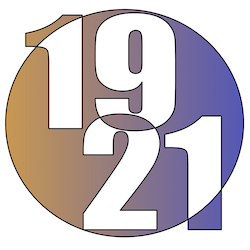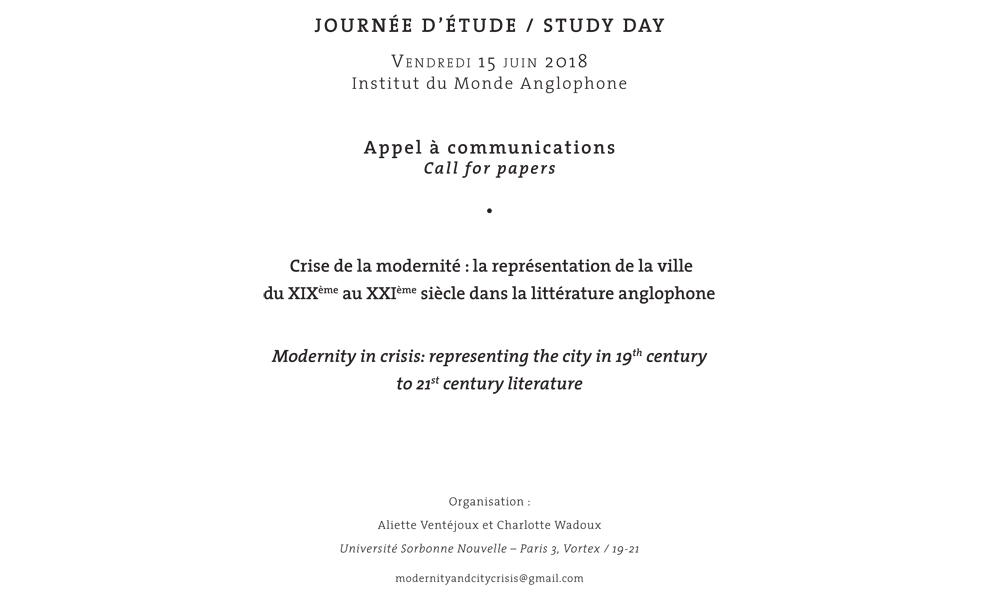JOURNÉE D’ÉTUDE / STUDY DAY
Vendredi 15 juin 2018 – Vous pouvez nous envoyer vos propositions jusqu’au 18 février 2018 (la date a été changée).
Institut du Monde Anglophone
Appel à communications (Vous pouvez le télécharger ici)
Call for papers
Crise de la modernité : la représentation de la ville du XIXème au XXIème siècle dans la littérature anglophone
Modernity in crisis: representing the city in 19th century to 21st century literature
Organisation :
Aliette Ventéjoux et Charlotte Wadoux Université Sorbonne Nouvelle – Paris 3, Vortex / 19-21
modernityandcitycrisis@gmail.com
Crise de la modernité : la représentation de la ville du XIXème au XXIème siècle dans la littérature anglophone
L’Angleterre, et de façon plus globale, l’Europe, se voient transformées au cours du dix-huitième siècle par la Révolution Industrielle qui accompagne l’essor de la ville. Mais c’est aussi, comme le fait remarquer Ian Watts dans The Rise of the Novel, la naissance d’un genre nouveau, celui du roman. La ville et le roman semblent donc d’emblée liés, le roman se faisant le porte-parole de la confusion qui règne dans les rues. Cela s’illustre notamment dans le roman du dix-neuvième siècle. Benjamin, dans ses Arcades et autres textes, voit dans cette relation l’expression de l’expérience de la modernité ou, pour être plus précis, du choc (et donc de la crise) de la modernité. Cette idée est reprise aujourd’hui et repensée d’un point de vue féministe, notamment par Lauren Elkin dans son ouvrage Flâneuse, qui se veut une relecture féminine de Benjamin.
Bien que les modernistes aient tenté de se détacher de leurs prédécesseurs Victoriens, la représentation de l’expérience de la ville est néanmoins présente dans la vision fragmentée que nous proposent le stream of consciousness de Ulysses ou encore les myriads of impression de Virginia Woolf, pour ne citer qu’eux. La question de la représentation de la ville vécue comme une crise est souvent abordée dans la littérature contemporaine. Que ce soit à travers la jungle du New York néo-gothique de Carter dans The Passion of the New Eve, l’hybridité générique de la biographie de Londres proposée par Peter Ackroyd, ou encore la réappropriation de la ville meurtrie et traumatisée après une catastrophe, telle le New York post-11 septembre chez Don DeLillo, la littérature anglophone nous offre une multitude d’exemples de villes en crise.
Les auteurs postcoloniaux ne sont pas en reste, bien au contraire. Qu’il s’agisse du Londres imaginaire de Naipaul dans The Enigma of Arrival ou du souvenir fragmenté de Bombay dans les textes de Salman Rushdie, la ville fascine et témoigne d’une crise du sujet et de son identité qu’il tente de reconstruire avec des morceaux de cartes, des cartes postales ou d’autres matériaux.
Il conviendra donc de s’interroger sur les changements survenus dans la ville contemporaine à la suite de catastrophes, qu’elles soient naturelles ou humaines (tempêtes, ouragans, terrorisme, guerres, accidents nucléaires, …). L’une des premières réponses à la catastrophe est bien souvent le recours au renforcement de la surveillance (comme le Patriot Act d’octobre 2001), qui a un impact non négligeable sur la manière d’appréhender la ville. Nous pourrons par exemple nous demander comment le renforcement de cette surveillance, suite à des attaques terroristes telles que celles du 11 septembre 2001 à New York ou du 7 juillet 2005 à Londres, ont pu ainsi changer le rapport à la ville, la circulation dans celle-ci, ou encore l’importance de la technologie (CCTV).
Cette journée d’étude, ouverte aux masterants, doctorants ou jeunes chercheurs, propose de s’interroger sur cette ville en crise dont nous parlent les romans anglophones depuis les aventures picaresques de Moll Flanders, jusqu’à la vision fragmentée que nous proposent les auteurs contemporains tels que Zadie Smith dans son roman NW, en passant par la représentation de la révolution chez Dickens dans A Tale of Two Cities.
Les thèmes suivants pourront être abordés (cette liste n’est pas exhaustive) :
- la ville et l’expérience de la modernité : flâneur / flâneuse ; explorer la ville,
- ville en éclat,
- possibilité / impossibilité de lire / cartographier la ville,
- l’écriture de la catastrophe dans la ville,
- le renforcement de la surveillance des citadins,
- trauma et mémoriaux,
- reconstruction / réappropriation de l’espace urbain,
- accidents / catastrophes naturelles,
- villes postcoloniales / villes et postcoloniaux,
- exil / diaspora / migration.
Mots clés :
Accident, cartographie, catastrophe, crise, flâneur, flâneuse, identité, reconstruction, réécriture, roman, surveillance, trauma, ville.
Invitée (confirmée) : Lauren Elkin, auteure de Flâneuse.
Les résumés de 200 mots, accompagnés d’une courte biographie, devront être adressés avant le 21 janvier 2018 à Aliette Ventéjoux et Charlotte Wadoux à l’adresse e-mail suivante :
modernityandcitycrisis@gmail.com
Les présentations pourront se faire en français ou en anglais.
Modernity in crisis:
representing the city in 19th century to 21st century literature
The Industrial Revolution brought many a transformation in eighteenth-century England (and more broadly Europe), one of the most important being the boom of the city. As Ian Watts states in The Rise of the Novel, it is at that time that a new genre emerged, that of the novel. The novel and the city thus seem to have been linked from the start, the novel becoming the voice of the chaos reigning in the streets, as several examples from the 19th century illustrate. In his collection of essays Arcades, as well as in other texts, Walter Benjamin finds in this relation the expression of the experience of modernity, or, to be more precise, of the shock (and the crisis) of modernity. Several critics have since then written about that topic, among whom Lauren Elkin in her recent book Flâneuse, which offers a feminist response to Benjamin’s male flâneur.
Although modernists tried to detach themselves from their Victorian predecessors, the representation and the experience of the city finds an expression in the fragmented vision that is offered by the stream of consciousness in Ulysses or Woolf’s “myriads of expressions”. The representation of the city in crisis is a ubiquitous topos of contemporary literature. Examples of these portrayals abound, amongst which are Carter and her neo-gothic jungle of New York in The Passion of the New Eve, Peter Ackroyd and his generically hybrid biography of London, or Don DeLillo, painting New York after September 11, 2001.
This issue is also of paramount importance for postcolonial studies. Indeed, postcolonial writers appropriate the city, as the imaginary London of Naipaul in The Enigma of Arrival, or the fragmented memories of Bombay in Salman Rushdie’s texts illustrate. The city is considered as a fascinating subject and is evidence of an ontological crisis of the subject who tries to reconstruct his/her identity thanks to pieces of maps, postcards, or other materials.
Last, but not least, changes happening in the contemporary city will be questioned, be they the consequence of natural or human catastrophes (hurricanes, terrorism, wars, nuclear accidents, …). One of the first responses to catastrophe is often the reinforcement of surveillance (the Patriot Act, October 2001), with a colossal impact on the way people apprehend the city. For instance, one could question the changes linked to the effects of the increase in surveillance following terrorist attacks (9.11 in New York, 7.7 in London), addressing among others the questions of the circulation in the city, or the importance of technology (CCTV).
This study day wishes to present the work of Master and PhD students as well as of young researchers who focus their research on the city in crisis, a topos which has been present in novels from Moll Flanders’ picaresque adventures to the fragmented vision given by Zadie Smith in NW, without forgetting the representation of revolution in Dickens’s A Tale of Two Cities.
Topics include, but are not limited to:
• fragmented city,
• experiencing modernity in the city: flâneur / flâneuse,
• possibility / impossibility of reading / mapping the city / deciphering the city, • writing the catastrophe in the city,
• reinforcing surveillance within the city,
• trauma and memorials,
• reconstruction / reappropriation of the urban space,
• accidents / natural catastrophes,
• postcolonial cities,
• exile / diaspora / migration.
Keywords:
Accident, cartography, catastrophe, city, crisis, flâneur, flâneuse, identity, reconstruction, rewriting, novel, surveillance, trauma.
Keynote Speaker (confirmed): Lauren Elkin, author of Flâneuse.
Please send a 200-word abstract and a short biographical note by 21 january 2018 to Aliette Ventéjoux and Charlotte Wadoux to:
modernityandcitycrisis@gmail.com
Presentations might be either in English or in French.
Bibliographie indicative / References and indicative bibliography:
Ackroyd, Peter. London: A Biography. London: Vintage. 2000.
Alter, Robert. Imagined Cities: Urban Experience and the Language of the Novel. New Haven, Conn.; London: Yale University Press. 2005.
Benjamin, Walter. The Arcades Project. [Passagen-Werk]. tr. Howard Eiland & Kevin McLaughlin. Cambridge, Mass.; London: Belknap Press. 1999.
Benjamin, Walter. “The Flâneur” in Charles Baudelaire: A Lyric Poet in the Era of High Capitalism. [1969] London: Verso. 1985.
Chevalier, Louis. Classes laborieuses, classes dangereuses : À Paris pendant la première moitié du dix- neuvième siècle. [1958] Paris : Perrin. 2007.
De Certeau, Michel. L’invention du quotidien. Vol. 1 : Arts de faire. Paris: Gallimard. 1990.
Elkin, Lauren. Flâneuse: Women Walk the City in Paris, New York, Tokyo, Venice and London. Londres: Chatto & Windus. 2016 .
Foucault, Michel. Surveiller et punir : naissance de la prison. Paris : Gallimard. 1975.
Golimowska, Karolina. The Post-9/11 City in Novels. Literary Remappings of New York and London. Jefferson: Mac Farland & Company. 2016.
Groes, Sebastian. The Making of London: London in Contemporary Literature. New York: Palgrave MacMillan. 2011.
McNamara, Kevin R. (ed.). The Cambridge Companion to the City in Literature. Cambridge: Cambridge University Press. 2014.
Mighall, Robert. A Geography of Victorian Gothic Fiction: Mapping History’s Nightmares. Oxford: Oxford University Press. 1999.
Moretti, Franco. Atlas of the European Novel, 1800-1900. London: Verso. 1999.
Nead, Lynda. Victorian Babylon: people, streets and images in nineteenth-century London. New Haven; London: Yale University Press. 2000.
Tally, Robert T. Jr. (ed.). Literary Cartographies: Spatiality, Representation, and Narrative. New York: Palgrave MacMillan. 2014.
Watt, Ian. The Rise of the Novel. [1957] London: Chatto & Windus, 1987. Woolf, Virginia. The Common Reader. London: Hogarth Press. 1929.
Wilhite, Keith. The City Since 9/11. Literature, Film, Television. Madison: Fairleigh Dickinson University Press. 2016.
Wilhite, Keith. Street Haunting and Other Essays. Ed. Sturat N. Clarke. London: Vintage Classics 2014.

